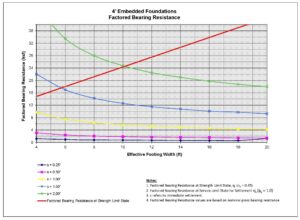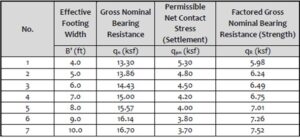Geotech Series Part I:
The design of foundations has historically been done using the method of Allowable Stress Design (ASD). This method uses Factors of Safety to determine whether a design “worked.” The factor of safety would vary depending on what was being checked but indicated how much larger the capacity had to be versus the demand.
Because ASD can be extremely conservative due to this one-size-fits-all approach, AASHTO and other design codes developed Load Factor Design (LFD) and eventually Load and Resistance Factor Design (LRFD). Based upon the predictability of how a building material (wood, concrete, steel, etc.) behaves, the behavior of these materials were “calibrated” and assigned a Resistance Factor. The different load types such as dead load, live load, wind loads, etc., were analyzed and given specific Load Factors.
The result is that the Factored Load (Demand) must be less than the Factored Resistance (Capacity). AASHTO published the first edition of LRFD in 1994 and in 2000 set a transition date of 2007 for all new bridges to follow LRFD. Caltrans fully adopted LRFD in 2010 for all design elements by Caltrans, with abutments and retaining walls being the last sections updated for LRFD.
In LFD and earlier versions of LRFD, the foundation section referred the designer back to the ASD method for sizing of the footing, because the Resistance Factors had yet to be truly developed and adopted. The foundations were sized per ASD, but the structural design was per LFD or LRFD. The geotechnical engineer would calculate a nominal bearing capacity and apply a factor of safety and would then provide the Allowable Bearing Capacity in their report. The structural designer would use unfactored loads with the allowable bearing capacity to size the foundation. The structural designer would then follow LFD or LRFD to determine the reinforcing and other structural elements.
Under the ASD method, both the strength of the soil and the anticipated settlement is accounted for in the allowable bearing capacity. In LRFD, these 2 values are decoupled. First, the strength of the soil is used to calculate a nominal bearing capacity to which a Resistance Factor (prescribed by AASHTO) is then applied to create a Factored Bearing Resistance. Next, the nominal bearing capacity is adjusted for the allowable settlement to create a Service Level Bearing Resistance. The structural designer then applies the appropriate Limit State load factors to check both the Service Level Bearing Resistance against the service level bearing pressure and the Strength Level Factored Bearing Resistance against the Factored Bearing Pressure. Additional checks are made at both the service and strength limit states for eccentricity and sliding according to the AASHTO code requirements.
Because the equations for Service level bearing resistance and the factored bearing resistance include the terms for width and depth of footing, it can be an iterative effort to do both the geotechnical and structural design of foundations in LRFD. A common solution is for the geotechnical professional to provide either a chart or table that provides the design values for a range of footing widths and/or depths. A sample of each is included below.







